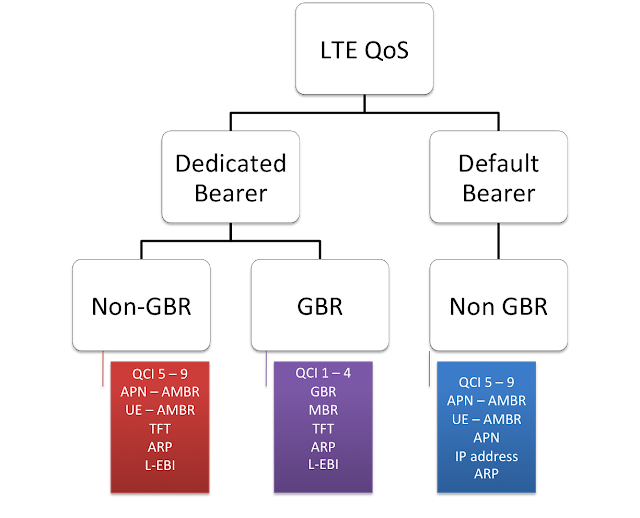Quality of Service (QoS) in LTE
Background: Why we need QoS ?
There are premium subscribers who always want to have better user experience on their 4G LTE device. These users are willing to pay more for high bandwidth and better network access on their devices. Not only the subscribers but some services itself need better priority handling in the network (e.g. VoIP call). To be able to full fill this, QOS plays the key role. QOS defines priorities for certain customers / services during the time of high congestion in the network
3GPP definition for QoS
between UE and PDN Gateway and is applied to a set of bearers. 'Bearer'
is basically a virtual concept and is a set of network configuration to
provide special treatment to set of traffic e.g. VoIP packets
are prioritized by network compared to web browser traffic.
In LTE, QoS is applied on Radio bearer, S1 bearer and S5/S8 bearer, collectively called as EPS bearer as shown in figure below.

bearer types and properties associated with each bearer
through hierarchical chart as shown below. First there are two types of
Bearer, i.e. Dedicated bearer and Default bearer. There is at-least one
default bearer established when UE is attached to LTE network while
dedicated bearer is always established when there is need to provide QoS
to specific service (like VoIP, video etc). Please go through the
article Default and Dedicated Bearer which hopefully will help to explain the concept in more detail.

maximum bit rate is the maximum allowed total non-GBR throughput to
specific APN. It is specified interdependently for uplink an downlink
can only be non-GBR type. Some other important terms associated with
each bearer type are discussed below:
retention priority is basically used for deciding whether new bearer
modification or establishment request should be accepted considering the
current resource situation.
is always associated with dedicated bearer and while default bearer may
or may not have TFT. As mentioned earlier, dedicated bearer provides QoS
to special service or application and TFT defines rules so that UE and
Network knows which IP packet should be sent on particular dedicated
bearer. It usually has rules on the basis of IP packet
destination/source or protocol used.
EPS bearer ID. As I discussed in previous article about dedicated and
default bearer, we know that each dedicated bearer is always linked to
one of default bearers. L-EBI tells Dedicated bearer which default
bearer it is attached to.
bearer is attached to some PDN network and has its own IP address while
dedicated bearer does not need this since it is linked to default
bearer.
associated with all bearers i.e. QoS class of identifier (QCI).This
parameter basically defines IP level packets characteristics as shown
below

Default bearer 1: Used for signaling messages (sip signaling) related to IMS network. It uses qci 5
Dedicated bearer: Used for VoLTE VoIP traffic. It uses qci 1 and is linked to default bearer 1
Default bearer 2: Used for all other smartphone traffic (video, chat, email, browser etc), assuming qci 9 is used here
associated with IMS PDN and has specific IP address. It has throughput
limitations defined in terms of A-AMBR and UE-AMBR. Since it has qci 5
which means that its IP packets has the highest priority over other IP
packets and maximum delay as 100ms between UE and PGW with packet loss
percentage up to 10-6
internet PDN and has specific IP. It has throughput limitations defined
in terms of A-AMBR and UE-AMBR as well. Since it has qci 9 which means
that its IP packets has the lowest priority over other IP packets and
maximum delay possible as 300ms between UE and PGW with packet loss
percentage up to 10-6
Default bearer 1 with L-EBI and it also has TFT which basically defines
which IP packets should be allowed to travel on this bearer. It has
throughput limitations defined in terms of MBR and GBR. Since it is
using QCI 1, the IP packets traveling on this bearer have the second
highest priority. The maximum delay possible to IP packets on this
bearer is 100 ms and the percentage of packet loss will be under 10-2
Quality of Service (QoS) in LTE的更多相关文章
- [转] Quality Of Service In OpenStack
http://tropicaldevel.wordpress.com/2013/07/15/quality-of-service-in-openstack/ In this post I will b ...
- Quality of Service 0, 1 & 2
来自:http://www.hivemq.com/blog/mqtt-essentials-part-6-mqtt-quality-of-service-levels Quality of Servi ...
- Quality of service
w https://en.wikipedia.org/wiki/Quality_of_service Quality of service (QoS) is the overall performan ...
- MQTT协议QoS服务质量 (Quality of Service 0, 1 & 2)概念学习
什么是 QoS ? QoS (Quality of Service) 是发送者和接收者之间,对于消息传递的可靠程度的协商. QoS 的设计是 MQTT 协议里的重点.作为专为物联网场景设计的协议,MQ ...
- neutron qos Quality of Service
Quality of Service advanced service is designed as a service plugin. The service is decoupled from t ...
- [译]Ocelot - Quality of Service
原文 可以针对每个ReRoute设置对下游服务的熔断器circuit breaker.这部分是通过Polly实现的. 将下面的配置添加到一个ReRoute下面去. "QoSOptions&q ...
- Default Bearer, Dedicated Bearer... What exactly is bearer ?
Default Bearer, Dedicated Bearer... What exactly is bearer ? While trying to get a better understa ...
- LTE QOS
http://wenku.baidu.com/link?url=ziFIkdKaC7MU2RY-bTOp2bt87WFPw5_02bqmYs5W6w4ktOfPHEcWesK1U2T7YiyXjVSM ...
- Information Centric Networking Based Service Centric Networking
A method implemented by a network device residing in a service domain, wherein the network device co ...
随机推荐
- ES6学习之函数扩展
函数默认参数 function test(x = 1, y = 2) { return x + y } test(5, 6) test() 若默认参数在必须参数之前,要想取得默认参数,只有当传入的值为 ...
- kvm基础 虚拟机内存、CPU调整
转自http://blog.csdn.net/hnhuangyiyang/article/details/50902223 一.调小虚拟机内存 调小虚拟机内存可以动态实现,不用关机1.查看当前内存大小 ...
- 关于javaScript事件委托的那些事
今天是第一次写稿,还是有那么一丢丢小鸡冻...回归正题啦... 关于javaScript事件委托不得不说的那些事,为什么要使用事件委托? 我们可以这么说,假设老板要分配一项任务,首先要秘书叫A君来到办 ...
- SVN使用技巧和参考文档总结
以下文章为网上收集: myEclipse 8.5下SVN环境的搭建(重点推荐) SVN建立版本库,配置用户和权限 Tortoise SVN使用方法,简易图解 版本控制软件SVN使用方法详解 学习笔记 ...
- RN控件之ProgressBarAndroid进度条
/** * Sample React Native App * https://github.com/facebook/react-native */ 'use strict'; import Rea ...
- 12.Weblogic 弱口令 && 后台getshell漏洞
利用docker环境模拟了一个真实的weblogic环境,其后台存在一个弱口令,并且前台存在任意文件读取漏洞. 分别通过这两种漏洞,模拟对weblogic场景的渗透. Weblogic版本:10.3. ...
- MD5Init-MD5Update-MD5Final
MD5Init是一个初始化函数,初始化核心变量,装入标准的幻数 MD5Update是MD5的主计算过程,inbuf是要变换的字节串,inputlen是长度,这个函数由getMD5ofStr调用,调用之 ...
- CODING 告诉你硅谷项目经理的项目管理之道(2)
优秀的项目管理者是怎么工作的?如何帮助研发团队高效工作?这一直是 CODING 关注的重要话题,我们不断地打磨 CODING 研发管理系统来让开发更简单. 近期我们精心挑选了几篇硅谷科技公司研发管理者 ...
- 「学习笔记」Fast Fourier Transform
前言 快速傅里叶变换(\(\text{Fast Fourier Transform,FFT}\) )是一种能在\(O(n \log n)\)的时间内完成多项式乘法的算法,在\(OI\)中的应用很多,是 ...
- Unity Shader着色器优化
https://mp.weixin.qq.com/s?__biz=MzU5MjQ1NTEwOA==&mid=2247493518&idx=1&sn=c51b92e9300bcf ...
